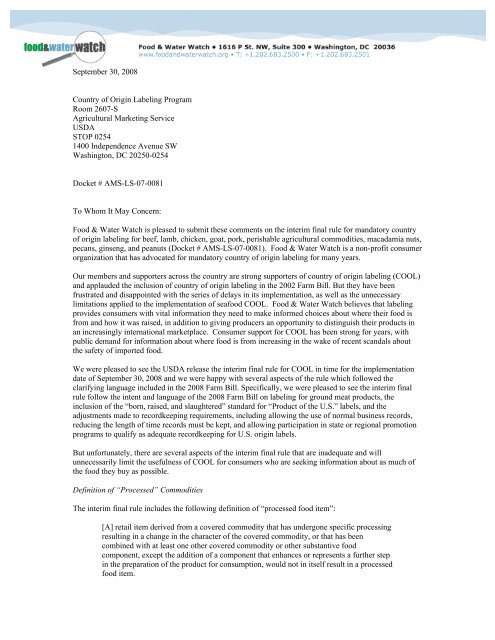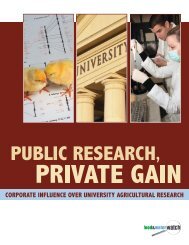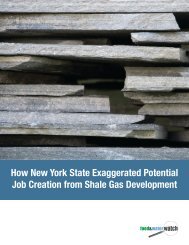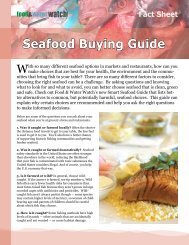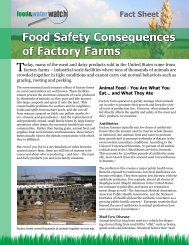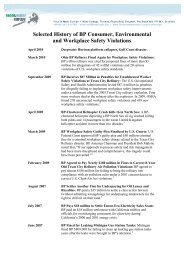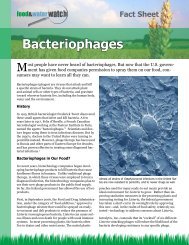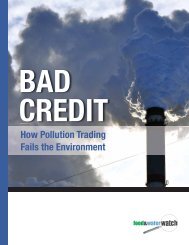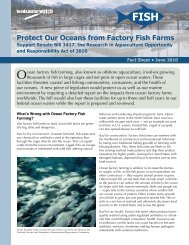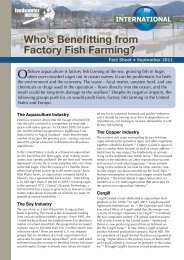COOL letter to USDA - Food & Water Watch
COOL letter to USDA - Food & Water Watch
COOL letter to USDA - Food & Water Watch
Create successful ePaper yourself
Turn your PDF publications into a flip-book with our unique Google optimized e-Paper software.
September 30, 2008<br />
Country of Origin Labeling Program<br />
Room 2607-S<br />
Agricultural Marketing Service<br />
<strong>USDA</strong><br />
STOP 0254<br />
1400 Independence Avenue SW<br />
Washing<strong>to</strong>n, DC 20250-0254<br />
Docket # AMS-LS-07-0081<br />
To Whom It May Concern:<br />
<strong>Food</strong> & <strong>Water</strong> <strong>Watch</strong> is pleased <strong>to</strong> submit these comments on the interim final rule for manda<strong>to</strong>ry country<br />
of origin labeling for beef, lamb, chicken, goat, pork, perishable agricultural commodities, macadamia nuts,<br />
pecans, ginseng, and peanuts (Docket # AMS-LS-07-0081). <strong>Food</strong> & <strong>Water</strong> <strong>Watch</strong> is a non-profit consumer<br />
organization that has advocated for manda<strong>to</strong>ry country of origin labeling for many years.<br />
Our members and supporters across the country are strong supporters of country of origin labeling (<strong>COOL</strong>)<br />
and applauded the inclusion of country of origin labeling in the 2002 Farm Bill. But they have been<br />
frustrated and disappointed with the series of delays in its implementation, as well as the unnecessary<br />
limitations applied <strong>to</strong> the implementation of seafood <strong>COOL</strong>. <strong>Food</strong> & <strong>Water</strong> <strong>Watch</strong> believes that labeling<br />
provides consumers with vital information they need <strong>to</strong> make informed choices about where their food is<br />
from and how it was raised, in addition <strong>to</strong> giving producers an opportunity <strong>to</strong> distinguish their products in<br />
an increasingly international marketplace. Consumer support for <strong>COOL</strong> has been strong for years, with<br />
public demand for information about where food is from increasing in the wake of recent scandals about<br />
the safety of imported food.<br />
We were pleased <strong>to</strong> see the <strong>USDA</strong> release the interim final rule for <strong>COOL</strong> in time for the implementation<br />
date of September 30, 2008 and we were happy with several aspects of the rule which followed the<br />
clarifying language included in the 2008 Farm Bill. Specifically, we were pleased <strong>to</strong> see the interim final<br />
rule follow the intent and language of the 2008 Farm Bill on labeling for ground meat products, the<br />
inclusion of the “born, raised, and slaughtered” standard for “Product of the U.S.” labels, and the<br />
adjustments made <strong>to</strong> recordkeeping requirements, including allowing the use of normal business records,<br />
reducing the length of time records must be kept, and allowing participation in state or regional promotion<br />
programs <strong>to</strong> qualify as adequate recordkeeping for U.S. origin labels.<br />
But unfortunately, there are several aspects of the interim final rule that are inadequate and will<br />
unnecessarily limit the usefulness of <strong>COOL</strong> for consumers who are seeking information about as much of<br />
the food they buy as possible.<br />
Definition of “Processed” Commodities<br />
The interim final rule includes the following definition of “processed food item”:<br />
[A] retail item derived from a covered commodity that has undergone specific processing<br />
resulting in a change in the character of the covered commodity, or that has been<br />
combined with at least one other covered commodity or other substantive food<br />
component, except the addition of a component that enhances or represents a further step<br />
in the preparation of the product for consumption, would not in itself result in a processed<br />
food item.
<strong>Food</strong> & <strong>Water</strong> <strong>Watch</strong> believes that this definition is inappropriately broad and will result in <strong>to</strong>o large of a<br />
quantity of food being exempt from labeling. This is contrary <strong>to</strong> what consumers expect from this labeling<br />
program as well as the intent of Congress when they included <strong>COOL</strong> in the last two Farm Bills. The result<br />
of this broad definition amounts <strong>to</strong> a loophole in the rule that leave large quantities of the commodities<br />
covered by the law exempt from labeling. These exemptions include:<br />
- 95 percent of peanuts, pecans, and macadamia nuts;<br />
- over 60 percent of pork;<br />
- the majority of frozen vegetables; and<br />
- the increasingly popular category of multi-ingredient fresh produce items such as salad<br />
mixes.<br />
These major exemptions do a disservice <strong>to</strong> consumers who are anxious <strong>to</strong> know where their food is from –<br />
and they are unnecessary. The agency’s position that simple procedures such as roasting, curing, and<br />
smoking classify a product as processed, and therefore exempt from labeling requirements, runs counter <strong>to</strong><br />
the agency’s own statement that the processing definition does not include “the addition of a component<br />
that enhances or represents a further step in the preparation of the product for consumption.” Steps such as<br />
roasting, curing, or smoking are taken <strong>to</strong> prepare foods like nuts or pork for consumption. These steps do<br />
not significantly alter the product, make it take on a different character, or make it untraceable. The act of<br />
roasting nuts or smoking muscle cuts of pork does not significantly alter the product from its original form<br />
– nor is it such a complicated process that food companies can’t keep track of the origin of these products.<br />
It is therefore unacceptable for these basic practices <strong>to</strong> be used as the trigger for classifying covered<br />
commodities as processed.<br />
Further, we are also concerned about AMS’ decision <strong>to</strong> make the addition of one other ingredient trigger<br />
the processed definition. If commingled products, such as a bag of frozen peas that contains peas from<br />
more than one source, have <strong>to</strong> be labeled with their country of origin, a bag that contains two covered<br />
commodities such as peas and carrots should also be labeled. Combining two ingredients does not change<br />
the character of these ingredients or make them unrecognizable or untraceable – and they should therefore<br />
be covered by the labeling requirement.<br />
<strong>Food</strong> & <strong>Water</strong> <strong>Watch</strong> urges AMS <strong>to</strong> significantly narrow the definition of “processed food item” contained<br />
in the interim final rule. Roasting, curing, smoking and other steps that make raw commodities more<br />
suitable for consumer use should not be the criteria for categorizing these commodities as processed and<br />
therefore exempt from labeling. In addition, AMS should revise the provision in the processing definition<br />
that states that combining covered commodities meets the definition of processed. If covered commodities<br />
are combined and are still recognizable, they should be required <strong>to</strong> be labeled. Consumers deserve <strong>to</strong> know<br />
where their food is from whether it is fresh or frozen, raw or smoked, and sold alone or combined with<br />
another covered commodity.<br />
Multi-Country Labels for Muscle Cuts of Meat<br />
One of the driving motivations for both consumers and producers who for years have advocated for<br />
manda<strong>to</strong>ry <strong>COOL</strong> has been their desire <strong>to</strong> see meat products that are labeled as products of the United<br />
States. So it is extremely disappointing that the interim final rule seems <strong>to</strong> have provided a loophole for<br />
meatpackers who wish <strong>to</strong> use a more generic North American label or mix meat from animals born, raised<br />
and slaughtered in the United States with meat from animals of other origin under a more generic multiple<br />
country label.<br />
The interim final rule states:
“if an animal was born, raised, and/or slaughtered in the United States and was not<br />
imported for immediate slaughter, the origin of the resulting meat products derived from<br />
that animal may be designated as ‘Product of the United States, Country X and/or (as<br />
applicable) Country Y’ where Country X and Country Y represent the actual or possible<br />
countries of foreign origin.”<br />
This language opens the door for meatpackers <strong>to</strong> mix U.S. origin animals in with imported animals and<br />
reduce the amount of U.S. origin meat available <strong>to</strong> consumers. We urge AMS <strong>to</strong> revise this language in the<br />
final rule. We believe this section runs contrary <strong>to</strong> what Congress intended and <strong>to</strong> what consumers and<br />
producers expect from this labeling program.<br />
Secretary Schafer recently <strong>to</strong>ld the National Association of State Departments of Agriculture that he<br />
supports a U.S. beef label. We hope that this support translates <strong>to</strong> a directive <strong>to</strong> AMS <strong>to</strong> revise this<br />
language – and agency guidance given <strong>to</strong> the meat industry – <strong>to</strong> ensure that U.S. origin animals are not<br />
mixed with meat from animals of other origins <strong>to</strong> avoid using a U.S. label. Congress, consumers, and<br />
producers have waited <strong>to</strong>o long for country of origin labeling <strong>to</strong> have the <strong>USDA</strong> create loopholes for the<br />
meatpacking industry <strong>to</strong> withhold valuable information about meat that could qualify as a product of the<br />
United States.<br />
60 Day Inven<strong>to</strong>ry Allowance<br />
An additional provision that concerns us is the provision that “when a raw material from a specific origin is<br />
not in a processor’s inven<strong>to</strong>ry for more than 60 days, the country shall no longer be included as a possible<br />
country of origin.” This seems <strong>to</strong> allow meatpackers <strong>to</strong> take up <strong>to</strong> 60 days <strong>to</strong> adjust their labels <strong>to</strong> remove a<br />
country that is no longer a source of their products. This seems excessively long and could lead <strong>to</strong><br />
misleading labeling. We believe this time period should be shortened in the final rule.<br />
Cost Benefit Analysis<br />
The AMS’ process for calculating the cost and benefits of implementing manda<strong>to</strong>ry <strong>COOL</strong> has been<br />
controversial in the past and this interim final rule contains bad assumptions and biases that are similar <strong>to</strong><br />
the agency’s previous attempts. Rather than rehash the widespread criticism of the agency’s previous<br />
attempts <strong>to</strong> estimate the costs and benefits of <strong>COOL</strong>, we will simply state that the agency has once again<br />
failed miserably when it comes <strong>to</strong> calculating benefits offered <strong>to</strong> consumers by manda<strong>to</strong>ry <strong>COOL</strong>.<br />
The interim final rule states repeatedly that the benefits <strong>to</strong> consumers of manda<strong>to</strong>ry <strong>COOL</strong> are so small that<br />
they cannot be quantified. We disagree with this assessment and point <strong>to</strong> the agency not only <strong>to</strong> public<br />
support for <strong>COOL</strong> documented in comments <strong>to</strong> the agency on previous rulemakings, but also public<br />
communications <strong>to</strong> Congress when they were deliberating on the Farm Bill and various appropriations bills<br />
that determined <strong>COOL</strong>’s implementation schedule and numerous polls that show consistent, widespread<br />
public support for this labeling program. But in addition <strong>to</strong> these qualitative examples of public support<br />
and consumer interest in <strong>COOL</strong>, there are studies of consumers’ willingness <strong>to</strong> pay for foods labeled with<br />
country of origin information. We are aware that AMS continues <strong>to</strong> dismiss all of this evidence of benefits<br />
<strong>to</strong> consumers. But we are troubled by the agency’s willingness <strong>to</strong> discard potentially useful pieces of<br />
information when it comes <strong>to</strong> calculating the benefits of this rule, while it seems quite willing <strong>to</strong> rely on<br />
extrapolations and weakly justified calculations when it comes <strong>to</strong> calculating the cost of the rule. We<br />
believe the lopsided nature of the interim final rule’s cost benefit assessment is just the latest example of<br />
AMS’ hostility <strong>to</strong> this labeling program.<br />
Labeling for Remotely Purchased Products<br />
We believe that the interim final rule provision on remotely purchased products is <strong>to</strong>o weak because it<br />
allows country of origin information <strong>to</strong> be disclosed either on the sales vehicle or at the time the product is<br />
delivered <strong>to</strong> the consumer. We believe that for origin information <strong>to</strong> be of use <strong>to</strong> consumers, it must be<br />
disclosed at the time they are making their purchasing decisions – which means the interim final rule
should not allow the disclosure of this information at the time of delivery. The time of delivery is <strong>to</strong>o late,<br />
because the product has already been purchased. We urge AMS <strong>to</strong> refine this language <strong>to</strong> require origin<br />
information <strong>to</strong> be disclosed on the sales vehicle (internet site or catalog.)<br />
Conclusion<br />
Consumers have waited far <strong>to</strong>o long for manda<strong>to</strong>ry country of origin labeling and we are happy <strong>to</strong> see this<br />
interim final rule going in<strong>to</strong> effect at last. But we urge AMS <strong>to</strong> revisit the areas we have identified in this<br />
comment so that labeling is as accurate as possible and consumers receive this vital information for as<br />
much of their food as possible.<br />
Sincerely,<br />
Executive Direc<strong>to</strong>r<br />
<strong>Food</strong> & <strong>Water</strong> <strong>Watch</strong>


